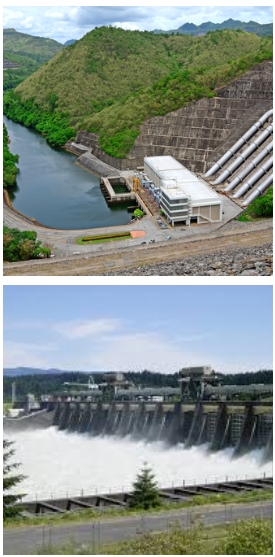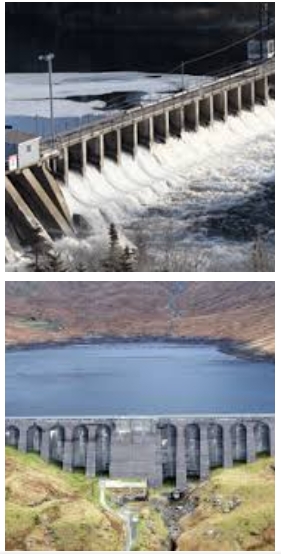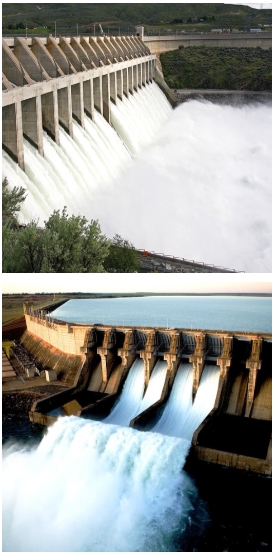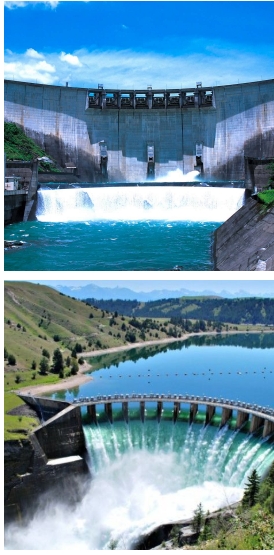Hydropower or water power is power derived from the energy of falling water or fast running water, which may be harnessed for useful purposes. Since ancient times, hydropower from many kinds of watermills has been used as a renewable energy source for irrigation and the operation of various mechanical devices, such as gristmills, sawmills, textile mills, trip hammers, dock cranes, domestic lifts, and ore mills. A trompe, which produces compressed air from falling water, is sometimes used to power other machinery at a distance. A hydroelectric power plant typically consists of a high dam that is built across a large river to create a reservoir, and a station where the process of energy conversion to electricity takes place. The first step in the generation of energy in a hydropower plant is the collection of run-off of seasonal rain and snow in lakes, streams and rivers, during the hydrological cycle. The run-off flows to dams downstream. The water falls through a dam, into the hydropower plant and turns a large wheel called a turbine. The turbine converts the energy of falling water into mechanical energy to drive the generator After this process has taken place electricity is transferred to the communities through transmission lines and the water is released back into the lakes, streams or rivers. This is entirely not harmful, because no pollutants are added to the water while it flows through the hydropower plant.
Hydropower types
Hydropower is used primarily to generate electricity. Broad categories include:
Conventional hydroelectric, referring to hydroelectric dams.
Run-of-the-river hydroelectricity, which captures the kinetic energy in rivers or streams, without a large reservoir and sometimes without the use of dams.
Small hydro projects are 10 megawatts or less and often have no artificial reservoirs.
Micro hydro projects provide a few kilowatts to a few hundred kilowatts to isolated homes, villages, or small industries.
Conduit hydroelectricity projects utilize water which has already been diverted for use elsewhere; in a municipal water system, for example.
Pumped-storage hydroelectricity stores water pumped uphill into reservoirs during periods of low demand to be released for generation when demand is high or system generation is low.
Sustainability
As with other forms of economic activity, hydropower projects can have both a positive and a negative environmental and social impact, because the construction of a dam and power plant, along with the impounding of a reservoir, creates certain social and physical changes. A number of tools have been developed to assist projects.
Most new hydropower project must undergo an Environmental and Social Impact Assessment. This provides a base line understand of the pre project conditions, estimates potential impacts and puts in place management plans to avoid, mitigate, or compensate for impacts.
The Hydropower Sustainability Assessment Protocol is another tool which can be used to promote and guide more sustainable hydropower projects. It is a methodology used to audit the performance of a hydropower project across more than twenty environmental, social, technical and economic topics. A Protocol assessment provides a rapid sustainability health check. It does not replace an environmental and social impact assessment (ESIA), which takes place over a much longer period of time, usually as a mandatory regulatory requirement.
The World Commission on Dams final report describes a framework for planning water and energy projects that is intended to protect dam-affected people and the environment, and ensure that the benefits from dams are more equitably distributed.
IFC’s Environmental and Social Performance Standards define IFC clients’ responsibilities for managing their environmental and social risks.
The World Bank’s safeguard policies are used by the Bank to help identify, avoid, and minimize harms to people and the environment caused by investment projects.
The Equator Principles is a risk management framework, adopted by financial institutions, for determining, assessing and managing environmental and social risk in projects.
Reservoirs accumulate plant material, which then decomposes, emitting methane in uneven bursts.






3P MANAGEMENT CONSULTANCY LLC © ALL RIGHTS RESERVED.
CONSULTING EXCELLENCE SINCE 2024 PROJECT FINANCE | CORPORATE FINANCE FDI | MANAGED BUY & SELL | SBLC | BG | HFT|REAL ESTATE | PROPERTY COLLABORATIONS | MANPOWER SUPPLY | HUMAN RESOURCES | DATA RESEARCH & ANALYTICS | STOCKS & DERIVATIVES TRADING | CUSTOMER CARE: +971555549266
